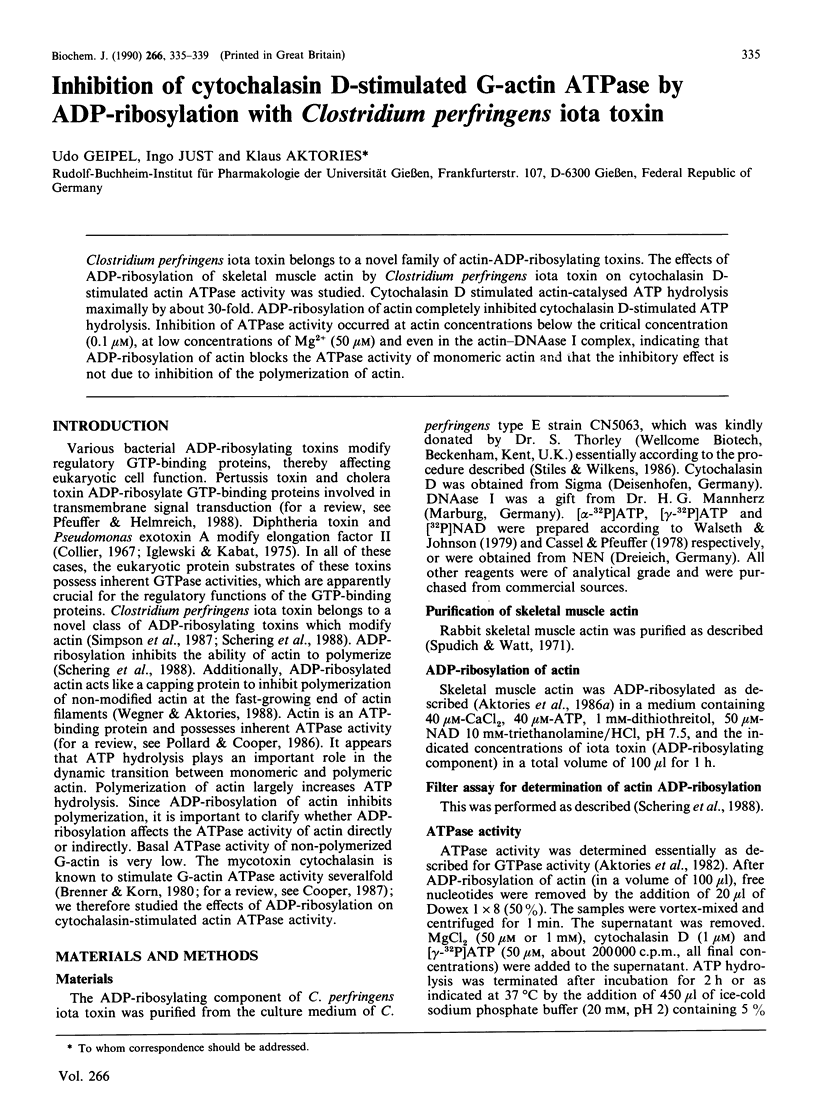Abstract
Clostridium perfringens iota toxin belongs to a novel family of actin-ADP-ribosylating toxins. The effects of ADP-ribosylation of skeletal muscle actin by Clostridium perfringens iota toxin on cytochalasin D-stimulated actin ATPase activity was studied. Cytochalasin D stimulated actin-catalysed ATP hydrolysis maximally by about 30-fold. ADP-ribosylation of actin completely inhibited cytochalasin D-stimulated ATP hydrolysis. Inhibition of ATPase activity occurred at actin concentrations below the critical concentration (0.1 microM), at low concentrations of Mg2+ (50 microM) and even in the actin-DNAase I complex, indicating that ADP-ribosylation of actin blocks the ATPase activity of monomeric actin and that the inhibitory effect is not due to inhibition of the polymerization of actin.
Full text
PDF




Images in this article
Selected References
These references are in PubMed. This may not be the complete list of references from this article.
- Aktories K., Ankenbauer T., Schering B., Jakobs K. H. ADP-ribosylation of platelet actin by botulinum C2 toxin. Eur J Biochem. 1986 Nov 17;161(1):155–162. doi: 10.1111/j.1432-1033.1986.tb10136.x. [DOI] [PubMed] [Google Scholar]
- Aktories K., Bärmann M., Ohishi I., Tsuyama S., Jakobs K. H., Habermann E. Botulinum C2 toxin ADP-ribosylates actin. Nature. 1986 Jul 24;322(6077):390–392. doi: 10.1038/322390a0. [DOI] [PubMed] [Google Scholar]
- Aktories K., Schultz G., Jakobs K. H. Stimulation of a low Km GTPase by inhibitors of adipocyte adenylate cyclase. Mol Pharmacol. 1982 Mar;21(2):336–342. [PubMed] [Google Scholar]
- Barden J. A., Kemp B. E. NMR of a synthetic peptide spanning the triphosphate binding site of adenosine 5'-triphosphate in actin. Biochemistry. 1987 Mar 10;26(5):1471–1478. doi: 10.1021/bi00379a039. [DOI] [PubMed] [Google Scholar]
- Brenner S. L., Korn E. D. The effects of cytochalasins on actin polymerization and actin ATPase provide insights into the mechanism of polymerization. J Biol Chem. 1980 Feb 10;255(3):841–844. [PubMed] [Google Scholar]
- Carlier M. F. Role of nucleotide hydrolysis in the polymerization of actin and tubulin. Cell Biophys. 1988 Jan-Jun;12:105–117. doi: 10.1007/BF02918353. [DOI] [PubMed] [Google Scholar]
- Cassel D., Pfeuffer T. Mechanism of cholera toxin action: covalent modification of the guanyl nucleotide-binding protein of the adenylate cyclase system. Proc Natl Acad Sci U S A. 1978 Jun;75(6):2669–2673. doi: 10.1073/pnas.75.6.2669. [DOI] [PMC free article] [PubMed] [Google Scholar]
- Collier R. J. Effect of diphtheria toxin on protein synthesis: inactivation of one of the transfer factors. J Mol Biol. 1967 Apr 14;25(1):83–98. doi: 10.1016/0022-2836(67)90280-x. [DOI] [PubMed] [Google Scholar]
- Cooper J. A. Effects of cytochalasin and phalloidin on actin. J Cell Biol. 1987 Oct;105(4):1473–1478. doi: 10.1083/jcb.105.4.1473. [DOI] [PMC free article] [PubMed] [Google Scholar]
- Geipel U., Just I., Schering B., Haas D., Aktories K. ADP-ribosylation of actin causes increase in the rate of ATP exchange and inhibition of ATP hydrolysis. Eur J Biochem. 1989 Jan 15;179(1):229–232. doi: 10.1111/j.1432-1033.1989.tb14545.x. [DOI] [PubMed] [Google Scholar]
- Goddette D. W., Frieden C. Actin polymerization. The mechanism of action of cytochalasin D. J Biol Chem. 1986 Dec 5;261(34):15974–15980. [PubMed] [Google Scholar]
- Hegyi G., Szilagyi L., Elzinga M. Photoaffinity labeling of the nucleotide binding site of actin. Biochemistry. 1986 Sep 23;25(19):5793–5798. doi: 10.1021/bi00367a067. [DOI] [PubMed] [Google Scholar]
- Iglewski B. H., Kabat D. NAD-dependent inhibition of protein synthesis by Pseudomonas aeruginosa toxin,. Proc Natl Acad Sci U S A. 1975 Jun;72(6):2284–2288. doi: 10.1073/pnas.72.6.2284. [DOI] [PMC free article] [PubMed] [Google Scholar]
- Laemmli U. K. Cleavage of structural proteins during the assembly of the head of bacteriophage T4. Nature. 1970 Aug 15;227(5259):680–685. doi: 10.1038/227680a0. [DOI] [PubMed] [Google Scholar]
- Pfeuffer T., Helmreich E. J. Structural and functional relationships of guanosine triphosphate binding proteins. Curr Top Cell Regul. 1988;29:129–216. doi: 10.1016/b978-0-12-152829-4.50006-9. [DOI] [PubMed] [Google Scholar]
- Pollard T. D., Cooper J. A. Actin and actin-binding proteins. A critical evaluation of mechanisms and functions. Annu Rev Biochem. 1986;55:987–1035. doi: 10.1146/annurev.bi.55.070186.005011. [DOI] [PubMed] [Google Scholar]
- Polzar B., Nowak E., Goody R. S., Mannherz H. G. The complex of actin and deoxyribonuclease I as a model system to study the interactions of nucleotides, cations and cytochalasin D with monomeric actin. Eur J Biochem. 1989 Jun 15;182(2):267–275. doi: 10.1111/j.1432-1033.1989.tb14826.x. [DOI] [PubMed] [Google Scholar]
- Schering B., Bärmann M., Chhatwal G. S., Geipel U., Aktories K. ADP-ribosylation of skeletal muscle and non-muscle actin by Clostridium perfringens iota toxin. Eur J Biochem. 1988 Jan 15;171(1-2):225–229. doi: 10.1111/j.1432-1033.1988.tb13780.x. [DOI] [PubMed] [Google Scholar]
- Simpson L. L., Stiles B. G., Zepeda H. H., Wilkins T. D. Molecular basis for the pathological actions of Clostridium perfringens iota toxin. Infect Immun. 1987 Jan;55(1):118–122. doi: 10.1128/iai.55.1.118-122.1987. [DOI] [PMC free article] [PubMed] [Google Scholar]
- Spudich J. A., Watt S. The regulation of rabbit skeletal muscle contraction. I. Biochemical studies of the interaction of the tropomyosin-troponin complex with actin and the proteolytic fragments of myosin. J Biol Chem. 1971 Aug 10;246(15):4866–4871. [PubMed] [Google Scholar]
- Stiles B. G., Wilkins T. D. Purification and characterization of Clostridium perfringens iota toxin: dependence on two nonlinked proteins for biological activity. Infect Immun. 1986 Dec;54(3):683–688. doi: 10.1128/iai.54.3.683-688.1986. [DOI] [PMC free article] [PubMed] [Google Scholar]
- Vandekerckhove J., Schering B., Bärmann M., Aktories K. Clostridium perfringens iota toxin ADP-ribosylates skeletal muscle actin in Arg-177. FEBS Lett. 1987 Dec 10;225(1-2):48–52. doi: 10.1016/0014-5793(87)81129-8. [DOI] [PubMed] [Google Scholar]
- Walseth T. F., Johnson R. A. The enzymatic preparation of [alpha-(32)P]nucleoside triphosphates, cyclic [32P] AMP, and cyclic [32P] GMP. Biochim Biophys Acta. 1979 Mar 28;562(1):11–31. doi: 10.1016/0005-2787(79)90122-9. [DOI] [PubMed] [Google Scholar]
- Wegner A., Aktories K. ADP-ribosylated actin caps the barbed ends of actin filaments. J Biol Chem. 1988 Sep 25;263(27):13739–13742. [PubMed] [Google Scholar]



